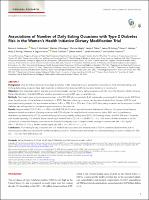Please use this identifier to cite or link to this item:
https://hdl.handle.net/20.500.12202/9923| Title: | Associations of number of daily eating occasions with type 2 diabetes risk in the Women’s Health Initiative Dietary Modification Trial |
| Authors: | Schnall, Eliezer Neuhouser, Marian L. Wertheim, Betsy C. Hingle, Melanie Tinker, Lesley F. Shikany, James M. Johnson, Karen C Waring, Molly E. Seguin-Fowler, Rebecca A Vitolins, Mara Z. Snetselaar, Linda Thomson, Cynthia |
| Keywords: | eating frequency 24-hour recall type 2 diabetes postmenopausal women cohort |
| Issue Date: | Aug-2020 |
| Publisher: | Elsevier Inc. |
| Citation: | Neuhouser, M.L., Wertheim, B.C., Perrigue, M.M., Hingle, M., Tinker, L.F., Shikany, J.M., Johnson, K.C., Waring, M.E., Seguin-Fowler, R.A., Vitolins, M.Z., Schnall, E. Snetselaar, L., & Thomson, C. (2020). Associations of number of daily eating occasions with type 2 diabetes risk in the Women’s Health Initiative Dietary Modification Trial. Current Developments in Nutrition, 4(8). |
| Series/Report no.: | Current Developments in Nutrition;4(8) |
| Abstract: | •Background• Over 23 million Americans have type 2 diabetes (T2D). Eating habits such as breakfast consumption, time-restricted eating, and limiting daily eating occasions have been explored as behaviors for reducing T2D risk, but prior evidence is inconclusive. ••Objectives Our objectives were to examine associations between number of daily eating occasions and T2D risk in the Women’s Health Initiative Dietary Modification Trial (WHI-DM) and whether associations vary by BMI, age, or race/ethnicity. ••Methods Participants were postmenopausal women in the WHI-DM who comprised a 4.6% subsample completing 24-h dietary recalls (24HRs) at years 3 and 6 as part of trial adherence activities (n = 2159). Numbers of eating occasions per day were obtained from the year 3 24HRs, and participants were grouped into approximate tertiles as 1–3 (n = 795), 4 (n = 713), and ≥5 (n = 651) daily eating occasions as the exposure. Incident diabetes was self-reported on semiannual questionnaires as the outcome. ••Results Approximately 15% (15.4%, n = 332) of the WHI-DM 24HR cohort reported incident diabetes at follow-up. Cox proportional hazards regression tested associations of eating occasions with T2D adjusted for neighborhood socioeconomic status, BMI, waist circumference, race/ethnicity, family history of T2D, recreational physical activity, Healthy Eating Index-2005, 24HR energy intake, and WHI-DM arm. Compared with women reporting 1–3 meals/d, those consuming 4 meals/d had a T2D HR = 1.38 (95% CI: 1.03, 1.84) without further increases in risk for ≥5 meals/d. In stratified analyses, associations for 4 meals/d compared with 1–3 meals/d were stronger in women with BMI <30.0 kg/m2 (HR = 1.55; 95% CI: 1.00, 2.39) and women aged ≥60 (HR = 1.61; 95% CI: 1.11, 2.33). ••Conclusions Four meals per day compared with 1–3 meals/d was associated with increased risk of T2D in postmenopausal women, but no dose–response effect was observed for additional eating occasions. Further studies are needed to understand eating occasions in relation to T2D risk. |
| Description: | Research article / Open access |
| URI: | https://cdn.nutrition.org/article/S2475-2991(22)12056-1/fulltext https://hdl.handle.net/20.500.12202/9923 |
| ISSN: | 2475-2991 |
| Appears in Collections: | Yeshiva College: Faculty Publications |
Files in This Item:
| File | Description | Size | Format | |
|---|---|---|---|---|
| Schnall 2020 OA Associations of number of daily eating occasions.pdf | 223.71 kB | Adobe PDF |  View/Open |
This item is licensed under a Creative Commons License

